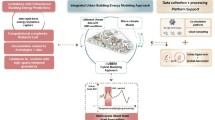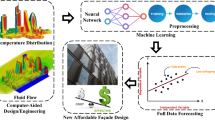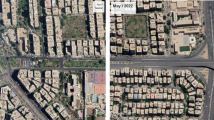Abstract
Energy conservation in buildings is greatly influenced by natural daylight in tropical region. A vital step towards development and promotion of daylighting technology in buildings is a prior study on estimation of exterior daylight availability for illuminating its interiors. In view of this, the present communication depicts the preliminary work progress carried out to arrive at a comprehensive idea on assessment of daylight availability and its characteristics. The study is reported taking the representative case of Bangalore (India) (latitude 12.97° N, longitude 77.56° E),which in future work facilitates to device suitable interior illuminance models and lighting controls for a daylight-artificial light integrated scheme. The objective of this paper is to document the estimation of spatial exterior daylight parameters like exterior horizontal as well as vertical global and diffuse daylight illuminance in addition to their respective luminous efficacies computed using an established analytical model. The paper also highlights user friendly computer simulation tool developed, for the detailed estimation of daylight availability at a particular region by the inclusion of corresponding solar radiation data.
Similar content being viewed by others
References
Chirarattananon S, Pornnimitra S, Chaiwiwatworakul P (2001). Modeling of global, diffuse horizontal, total vertical and beam normal illuminance and irradiance. In: Proceedings of the Workshop on Daylight for Buildings in the Tropics IV, Bangkok. pp. 1–28.
Chirarattanon S, Rukkwansuk P, Chaiwiwatworakul P, Pakdeepol P (2007). Evaluation of vertical illuminance and irradiance models against data from north Bankok. Building and Environment, 42 (11): 3894–3904.
Colaco SG, Kurian CP, George VI, Colaco AM (2008). Prospective techniques of effective daylight harvesting in commercial buildings by employing window glazing, dynamic shading devices and dimming control-A literature review. Building Simulation, 1(4): 279–289.
ECBC (2007). Energy Conservation Building Code. Ministry of Power, Govt. of India, India.
Joshi M, Sawhney RL, Buddhi D (2007). Estimation of luminous efficacy of daylight and exterior illuminance for composite climate of Indore city in Mid Western India. Renewable energy, 32(8): 1363–1378.
Kurian CP (2006). Advanced lighting simulation tools: An asset to assess energy saving potentials in lighting. Lighting India magazine, May–June: 78–89.
Kurian CP, Aithal RS, Bhat J, George VI (2008). Robust control and optimization of energy consumption in daylight-Artificial light integrated schemes. Lighting Research and Technology, 40(1): 7–24.
Littlefair PJ (1985). The luminous efficacy of daylight: A review. Lighting Research and Technology, 17(4):162–182.
Li DHW, Lam JC (2000). Evaluation of slope irradiance and illuminance models against measured Hong Kong data. Building and Environment, 35(6): 501–509.
Liu BYH, Jordan RC (1962). Daily insolation on surfaces tilted towards the equator. ASHRAE Journal, 3(10): 53.
Love JA (1992). The evolution of performance indicators for the evaluation of daylighting systems. IEEE Industry Applications Society Annual Meeting, 2: 1830–1836.
MATLAB API Reference, The MathWorks Inc., USA, http://www.mathworks.com.
Muneer T, Angus TC (1993). Daylight illuminance models for the United Kingdom. Lighting Research and Technology, 25(3): 113–123
Muneer T (1996), Evaluation of luminous efficacy against Japanese data. Ambient Energy, 17 (4):112–116.
Pattanasethanon S, Lertsatitthanakorn C, Atthajariyakul S, Soponronnarit S (2007). All sky modeling daylight availability and illuminance/irradiance on horizontal plane for Mahasarakham, Thailand. Energy Conversion and Management, 48(5): 1601–1614.
Perez R, Ineichen PS, Seals R, Mchalsky J, Stewart R (1990). Modeling daylight availability and irradiance components from direct and global irradiance. Solar Energy, 44(5): 271–289.
Perez R, Ineichen P, Seals R, Michalsky J, Stewart R (1993). All weather model for sky luminance distribution-Preliminary configuration and variation. Solar Energy, 50(3): 235–245.
Rea MS (2000). Lighting Handbook: Reference and Application, 9th edn. Illuminating Engineering Society of North America (IESNA). pp. 359–381.
Soler A, Robledo L (2000). Global luminous efficacies on vertical surfaces for all sky types. Renewable Energy, 19(1-2): 61–64.
Vartianen E (2000). A comparison of luminous efficacy models with illuminance and irradiance measurements. Renewable Energy, 20(3): 265–277.
Zain-Ahmed A, Sopian K, Zainol Abidin Z, Othman MYH (2002). The availability of daylight from tropical skies-A case study of Malaysia. Renewable Energy, 25(1): 21–30.
Author information
Authors and Affiliations
Corresponding author
Rights and permissions
About this article
Cite this article
Colaco, S.G., Kurian, C.P., George, V.I. et al. Model based evaluation of exterior daylight illuminance distribution. Build. Simul. 2, 85–94 (2009). https://doi.org/10.1007/s12273-009-9113-4
Received:
Revised:
Accepted:
Published:
Issue Date:
DOI: https://doi.org/10.1007/s12273-009-9113-4




